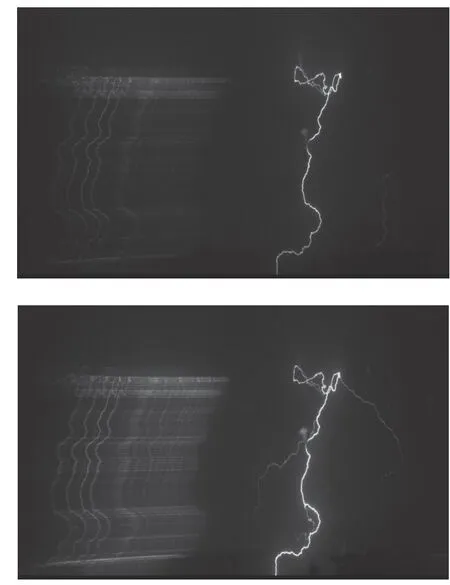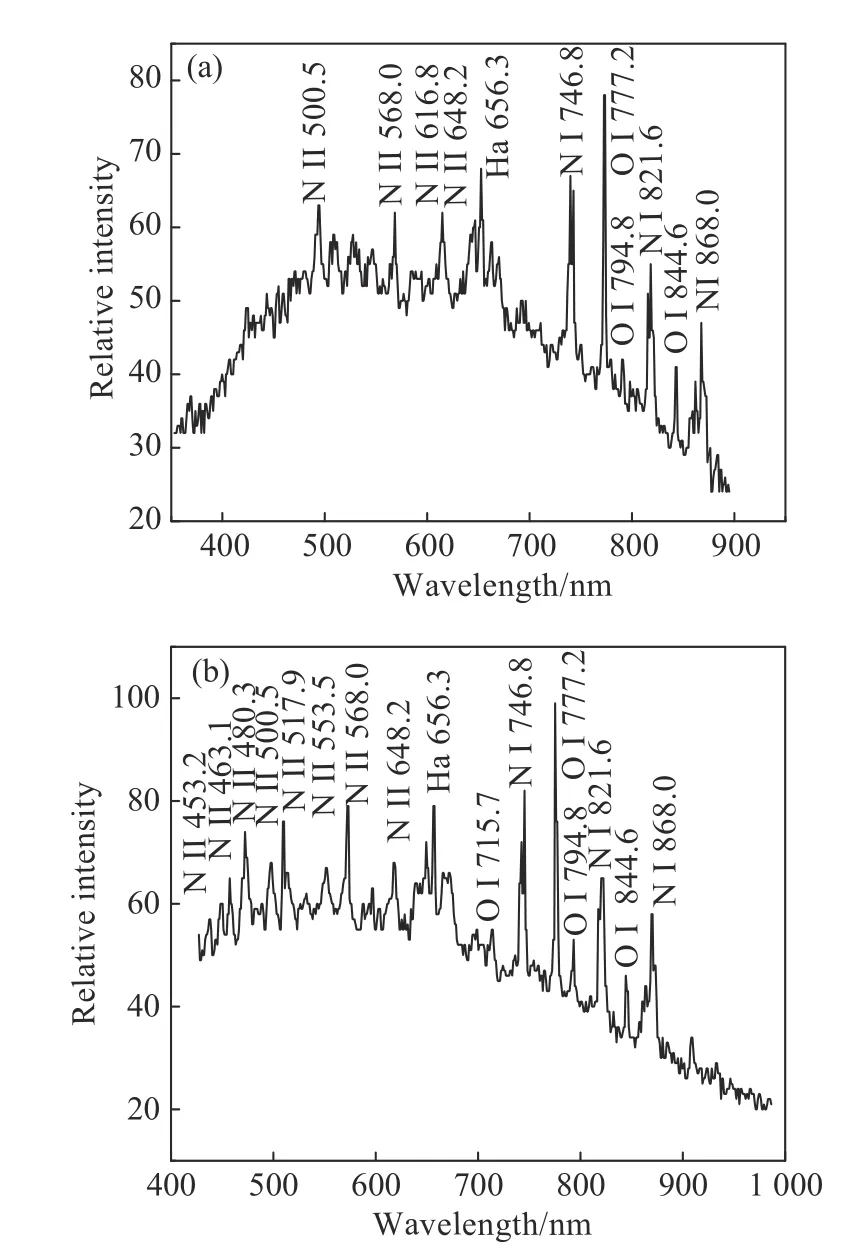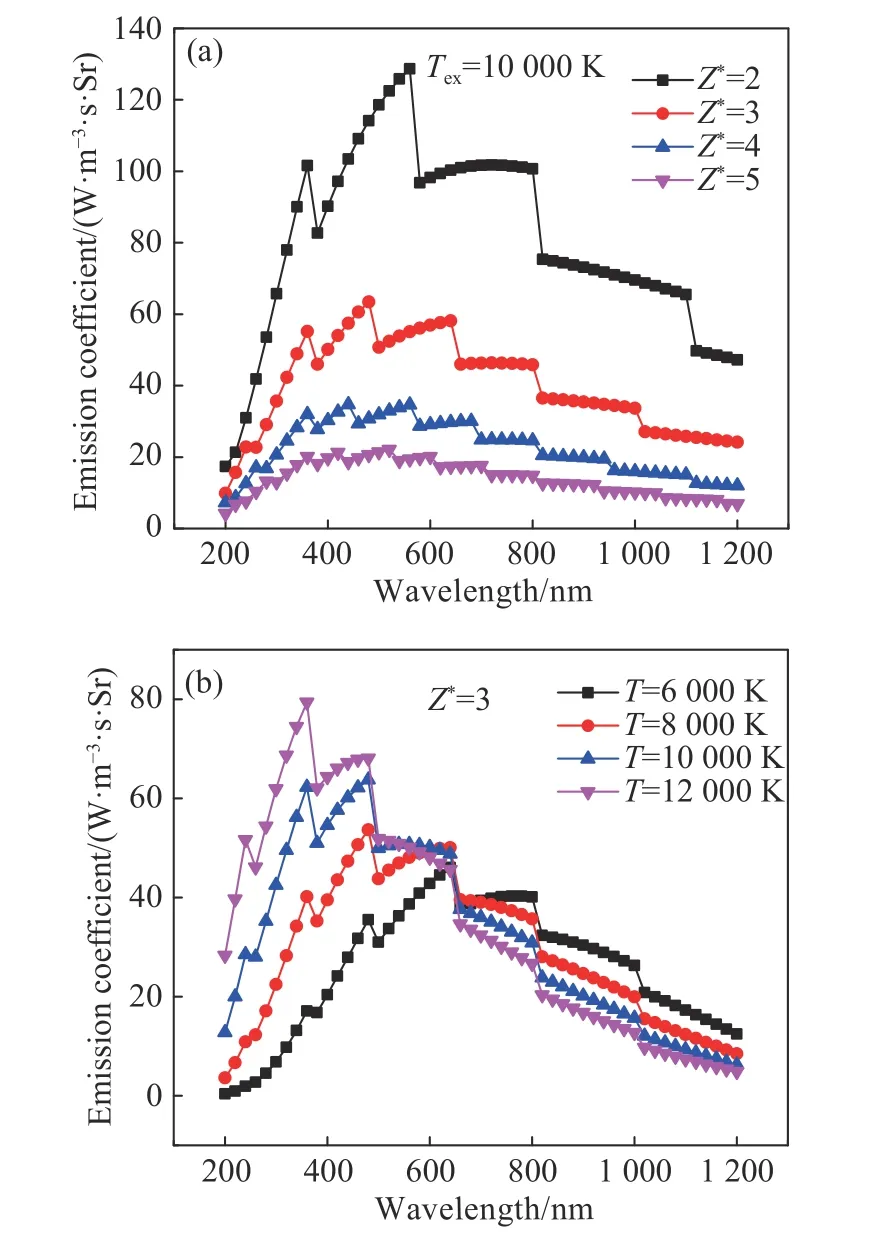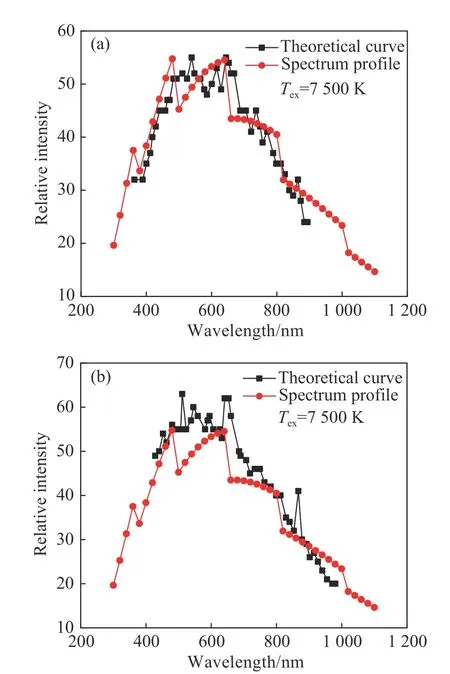Formation mechanism of the continuous spectral profile of lightning plasma
DONG Xiang-cheng ,WANG Guo-wei,CHEN Jian-hong
(1. BaiLie School of Petroleum Engineering, Lanzhou City University, Lanzhou 730070, China;2. School of Electronic and Information Engineering, Lanzhou City University, Lanzhou 730070, China)
* Corresponding author,E-mail: dongxiangc@tom.com
Abstract: The cloud-to-ground lightning discharge spectrum was recorded using a slitless grating spectrograph with a spectral range of 400~1 000 nm. Abundant monovalent nitrogen ion lines were observed in the lower-frequency range of the visible spectra, whereas other important ion lines were not clearly observed.Under the action of the cloud-to-ground electric field, a large number of electrons in the lightning plasma channel poured onto the ground and quickly heated the channel, such that the temperature decreased along the radial direction of the channel. This process enhanced the interaction between the nitrogen ions and the electrons near the channel surface, producing continuous radiation. The continuous radiation mechanism of lightning mainly includes bremsstrahlung and recombination radiation, which correspond to the Coulomb collision between the nitrogen ions and free electrons and the capture of free electrons. When the plasma temperature is lower than 10,000 K, the continuous bremsstrahlung spectrum is a flat spectrum, which has no obvious influence on the profile characteristics of the continuous spectrum in the visible light range. For recombination radiation, an approximate calculation method for non-hydrogen-like complex ions was introduced on the basis of the classic hydrogen-like ion radiation theory. The Gaunt factor was used for quantum mechanic correction to analyze the recombination radiation process of nitrogen ions, on the basis of above, the functional relationship between the recombination radiation coefficient of the continuous spectrum and the wavelength was derived. Finally, a characteristic curve was drawn for the continuous radiation spectrum of nitrogen plasma. The curve was compared with the observed profile of the continuous lightning spectrum, revealing that the temperature of the electrons on the plasma surface is closely related to the position of the continuous radiation spectrum peak; the effective nuclear charge number Z* of the introduced nitrogen ions has a significant effect on step feature and broadening characteristics of the continuum spectrum. By comparison, when Z* was set to 3, the theoretical curve was highly consistent with the profile characteristics of the continuous spectrum. The range of Z* was determined by the type of ions. The introduction of Z* could help to effectively explain the step feature of the continuous spectrum of the lightning plasma at a given wavelength.
Key words: lightning spectra; continuous radiation; spectral profile feature; electron temperature
1 Introduction
Plasma spectroscopy is a focus of frontier research and has broad application prospects in fields such as space physics, high-voltage breakdown and material processing[1]. Lightning is a type of common natural atmospheric gas discharge plasma.There are many types of particles in lightning discharge plasma, that collide with one other frequently, accompanied by an increasingly violent discharge process[2], hampering direct measurement of its parameters, thus making spectrometry an important means of indirectly measuring and studing its characteristics. Lightning plasma spectra are characterized by superposition of line spectra over strongly continuous spectra, which are closely related to the initiation, stabilization and disappearance of the lightning, thereby significantly impacting the accurate measurement of the linear spectra[3].Many results have been achieved in research on the linear spectra of lightning. Owing to the complexity of the formation mechanism of continuous spectra,there remain few studies on the continuous radiation spectra of plasma. So, it is of great significance to research the development and dissipation of low-temperature thermal plasma and the process of energy transmission inside plasma.
In the process of cloud-to-ground discharge,lower atmospheric changes have a higher research value. The lower atmospheric layer consists of clean dry air, water vapor, and pollutants, of which clean dry air is the main component. To simplify the analysis process, atmospheric ionization by lightning is reducible to the ionization of clean dry air. Nitrogen is the major component of clean dry air, accounting for about 78.08% by volume, while oxygen accounts for about 20.95% and inert gases account for about 0.93%. The generation of lightning plasma is mainly due to nitrogen and oxygen. When the equilibrium temperature of the gases is about 10,000 K,all oxygen and nitrogen molecules are in the atomic state[4-5], and the typical temperature of the lightning discharge return stroke channel is normally 10,000 K.So, without considering the molecular spectra in the channel[6], after elimination of stray light, the continuous spectra are determined by the bremsstrahlung and recombination radiation processes.
2 Theoretical methodology
2.1 Effect of bremsstrahlung on continuous spectra
Bremsstrahlung is generated by a sudden change in the speed of electron motion in plasma. It is divided into electronic-atomic bremsstrahlung generated by electrons under the action of the nuclear electric field, and electronic-ionic bremsstrahlung generated under the action of the ion Coulomb field.The avalanche of ionization energy generated in the formation process of a lightning channel highly ionizes the center of the channel. Considering the very low atomic density inside, the effect of electronicatomic bremsstrahlung on the continuous spectra can be ignored. The high temperature in the return stroke channel drives ions toward the thermal equilibrium state, and the electron velocity follows the Maxwell distribution. Electrons at various initial velocities contribute to the monochromatic radiation waves within the range. The radiation coefficient for the collective spectra of the thermal equilibrium plasma electrons with temperatureTinis[7-11]:

where C1=5.44×10?52·c·Z2·Ne·NZ·gff(Tin,λ), in which Neand NZrespectively represent electron density and ion density; Z represents the ionic charge number; and gff(Tin,λ) represents the mean Gaunt quantum mechanics revision factor.C1has no impact on the continuous spectral profile of bremsstrahlung, while the spectral intensity tends to rise first and then decrease asC1increases. The main factors affectingC1include electron densityNeand ion density NZ. In a low-temperature plasma,owing to the low mean velocity of electrons, the gff(Tin,λ) and the ionic charge number Z have little impact onC1. As can be seen from Equation (1),when the wavelength is less than 200 nm, the effect of bremsstrahlung is significant. When the wavelength is greater than 200 nm, the bremsstrahlung is characterized by flat spectra. The experimental observation shows that the continuous spectral peak of lightning mainly appears between 400 nm and 600 nm, and bremsstrahlung has no appreciable impact on its profile features.
2.2 Effect of recombination radiation on continuous spectra
Freely moving electrons in plasma are captured by ions, producing recombination radiation as they bind. The higher the plasma temperature, the greater the average kinetic energy of the electrons, and the higher the frequency of the continuous radiation.After being captured by ions, the electrons may be in a highly excited state, and the atomic spectra generated during electron transition to a lower level is known as complex-cascade radiation recombination radiation. It contributes to the monochromatic radiation waves within the range. For local thermal equilibrium hydrogen plasma with a temperature ofTex, the recombination radiation coefficient in the channel is represented by[7-11]:

where gi,1represents the statistical weight of groundstate ions, and Uiis a partition function. For a hydrogen plasma in excited state, gi,1≈Ui, and gfb(Tex,λ)represents the average Gaunt factor of the recombination radiation.
The above theory is applicable to hydrogen and hydrogen-like plasmas. For lightning plasma, it can be improved through parameter correction and approximation based on an analysis of the spectral features of lightning. A slitless spectrograph consisting of a high-speed camera and a plane transmission grating with 600 lines/mm, was used to record a spectral image of a lightning return stroke in Qinghai, as shown in Figure 1. The high-speed camera was operated at 6000 frames per second (fps), and the time interval between the two images in Figure 1 is 0.117 ms.

Fig. 1 Images of time-sharing lightning beam
The image was interpreted with reference to the National Institute of Standards and Technology(NIST) Atomic Spectra Database, obtaining spectra of the same beam at different heights from the ground, as shown in Figure 2. Figure 2(a) shows the spectrum at a high elevation while Figure 2(b)shows the spectrum at a low elevation. Figure 2 shows that the main component of the positive ions in the lightning plasma is N Ⅱ, so equation (2) can not be completely suitable for analyzing the continuous spectra of lightning plasma and must be revised. Lightning spectra are quite similar to the spectra of welding arc plasma[12]. The temperature is highest at the center of the discharge channel[13]and the core current channel is very thin while the charge density is high. Thus, an electric field is generated radially from the channel, driving charges outward to form an electric light beam layer, with a gradually decreasing temperature. Therefore, the lightning channel is regarded as a plasma column whose temperature decreases from the inside out.The core current channel is at a high temperature and its continuous radiation is dominated by bremsstrahlung. The light beam layer outside the channel is at a low temperature, and the continuous radiation is dominated by recombination radiation.

Fig. 2 Spectra of the lightning beam at different heights from the ground
Figure 2 shows a large number of N II spectral lines on the short-wave band, while other spectra are not clearly visible. Considering that continuous spectra are mainly generated by monovalent nitrogen ions, Equation (2) needs to be revised. Because electrons are very likely to enter a highly excited state when captured by ions, in approximation, nitrogen ions and electrons form a hydrogen-like system. The energy of the electrons for photon radiation in the complex process is as follows:

whereE1represents the first ionization energy 14.53 eV of the nitrogen atoms;Enrepresents thenthexcitation energy of the nitrogen atoms,E∞=0 is its minimum, while the first ionization energy of nitrogen atoms is its maximum. Formula (3) shows that continuous radiation spectra are not smooth in the recombination radiation process. A transition peak exists atEnand the ionization energyE1?En≤hv, compounded to allnenergy levels, affects the total emission coefficient of the continuous radiation. The ionization energy (E1?En) at thenthenergy level can be approximately represented as the ionization energy of hydrogen atoms.

whereRyrepresents the Rydberg energy, andZ*represents the effective charge number in nitrogen ions.Thus, the value ofn( λ) can be determined as follows:

The value ofZ*should be between 2 and 7, so Equation (2) is revised as follows:

whereC2=5.44×10?52·c·Z4·Ne·NZ, in whichC2has no impact on the continuous shape of the recombination radiation spectra, andE1,nrepresents the energy released by the electrons when captured at thenthenergy level. Low-temperature thermal plasmaGn(λ)can be set as a function that decreases linearly from 5 to 1 as the wavelength increases[14-15].
3 Comparison between the profile features of the theoretical and experimental continuous spectra curves
3.1 Characteristics of the theoretical curve
The wavelength is set to 200?1200 nm. The surface temperature of the plasma columnTexis set to 8×103?1 .2×104K ,E1,n=1eV,En=13.6 eV, andZ*is set to 2?5.
Lightning plasma is considered to be optically thin, so the spectral intensity is positively correlated with the radiation coefficient of the spectra[16,17]. The functional curve of the spectral radiation coefficient is compared with the profile of the continuous radiation spectrum. As shown in Figure 3(a), asZ*increases, the transition features of the spectral shape weaken, as does the radiation intensity. This can be interpreted as a decrease in the probability that free electrons are captured into the inner orbit of the ions. As shown in Figure 3(b), as the plasma temperatureTexincreases, the continuous spectral peak shifts significantly toward the short-wave, and the radiation intensity changes slightly. This can be interpreted as a violet shift of the continuous spectra caused by an increase in the proportion of high-energy free electrons.

Fig. 3 Effect of Tex and Z* on the profile features of the continuous spectra
The continuous spectral envelope in Figure 2 is extracted and compared with the curve in Figure 3.Setting the temperature to 7,500 K and the effective charge number in the ions to 3, a continuous theoretical spectral profile is drawn and compared with the continuous spectral profile in Figure 2, as shown in Figure 4.

Fig. 4 Comparison between the experimental and theoretical profile features of the continuous spectra (Z*=3)
As shown in Figure 4, the theoretical curve fits well with the experimental spectral profile. In Figure 4(b), the experimental spectral intensity is greater than the theoretical spectral intensity. This is because Figure 4(b) corresponds to the continuous spectra of the near-ground lightning plasma column.The ion density in the return stroke channel should be greater than the particle density corresponding to Figure 4(a). The calculation results show that the near-ground ion density in the return stroke channel is about 1.14 times that at the top.
3.2 Comparative feature analysis of the theoretical curve and experimental spectral profile
The comparison between the linear theoretical curve of continuous radiation spectra and the continuous spectral profile features of lightning spectra shows that bremsstrahlung contributes little to changes in the continuous spectral profile within the spectral frequency and temperature range of lightning plasma. It only affects the short-wave band with no significant effect on the medium or longwave bands[18]. Quantum mechanics revision, a continuous radiation theory based on classical physics,was realized through the Gaunt factor, which is normally set to a constant close to or greater than 1 in low-temperature plasma. In contrast to welding arc plasma, the factor was set to a quantity that changed linearly with the wavelength. Taking the Gaunt factor into consideration, limb broadening was diminished on the theoretical continuous spectrum profile, becoming more consistent with the experimental profile. The plasma electron temperature showed the most significant effect on the profile. As the temperature rose, the spectral peak shifted toward the short-wave. As shown in Figure 4, the experimental spectral profile is most consistent with the theoretical curve at 7500 K. This result falls within the range of results defined by the continuous spectral slope method in Ref. [19]. Ion species is another important factor affecting the continuous spectral profile. The larger the atomic number of the ions, the weaker the transition features of the resulting continuum spectra.
4 Conclusions
The Gaunt factor has been used for quantum mechanics revision on the basis of the classical theory of hydrogen-like ions. Considering that free electrons are very likely to enter a highly excited atomic state, ions′ effective charge number or groundstate ionization energy can be revised to approximate monovalent nitrogen ions by viewing them as hydrogen-like ions. This establishes a theoretical formula for the continuous spectral radiation coefficient of nitrogen plasma. The consistency between the continuous spectral profile features of the theoretical curve and lightning plasma was verified, revealing that plasma temperature has the most significant effect on the continuous spectral profile features and plays a major role in locating the spectral peak with respect to the wavelength. Second, the effective nuclear charge number following the approximation of nitrogen ions as hydrogen-like ions plays a major role in promoting the appearance of the continuous spectral transition peak and also has an effect on the limb broadening of the continuous spectra.
- 中國光學的其它文章
- Surface plasmon resonance characteristics of a graphene nano-disk based on three-dimensional boundary element method
- A new automatic cell smear and laser release system for near-infrared light responsive release of nucleated red blood cells
- Design of optical wedge demodulation system for fiber Fabry-Perot sensor
- Photon-assisted Fano resonance tunneling periodic double-well potential characteristics
- 中國遙感衛星輻射校正場敦煌戈壁場區光環境變化研究
- 油氣井下光纖光柵溫度壓力傳感器

